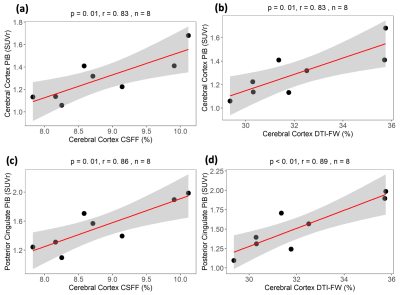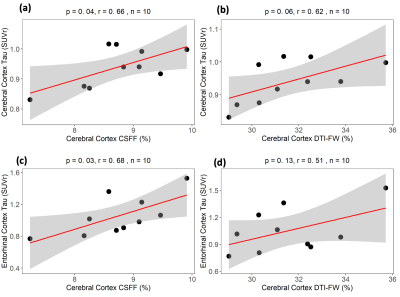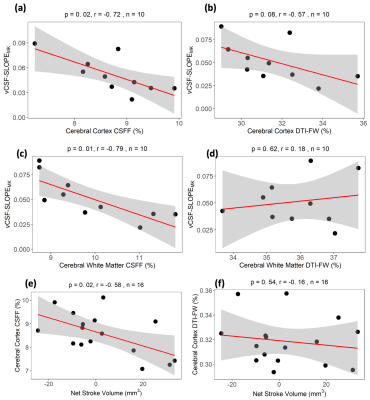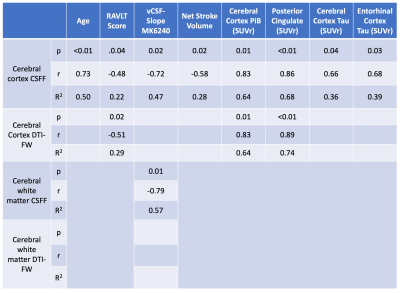4375
T2 relaxometry based CSF fraction (CSFF) mapping is a better biomarker for brain drainage pathology than DTI-based free water (DTI-FW) mapping
Liangdong Zhou1, Thanh Nguyen2, and Yi Li2
1Radiology, Weill Cornell Medicine, New York, NY, United States, 2Weill Cornell Medicine, New York, NY, United States
1Radiology, Weill Cornell Medicine, New York, NY, United States, 2Weill Cornell Medicine, New York, NY, United States
Synopsis
We compared two free water methods, T2 relaxometry-based CSFF and DTI-based DTI-FW, by associating them with age, cognitive score RAVLT, amyloid beta deposition from PiB SUVr, tau deposition from MK6240, aqueduct CSF flow from PC-MRI and ventricle CSF clearance from MK-PET. Results show that CSFF outperforms DTI-FW in most relation pairs. CSFF works great for quantifying clearance related measures but DTI-FW failed.
Introduction
Glymphatic clearance is important to maintain brain health, and its dysfunction is associated with the development of AD1. The perivascular space (PVS) is a known key route of glymphatic clearance for the drainage of interstitial fluid and solutes such as soluble amyloid-beta (Aβ) and tau from the brain2,3. Recent studies have shown that the dilation of the PVS is related to the obstruction of the bulk flow of CSF, which is secondary to the deposition of Aβ in the walls of small cortical arteries and arterioles and the reduction of the driving force. The dilation of the PVS may relate to abnormal protein (eg, Aβ, tau) accumulation during aging as well. Magnetic resonance (MR) T2 relaxometry-based free water mapping i.e., cerebrospinal fluid fraction (CSFF), can be used for the quantification of early PVS dilation due to that the long T2 signal is contributed from the free water (CSF) in PVS4. Diffusion tensor imaging can also be used to map free water (DTI-FW) by fitting a two-compartment model, in which the free water compartment is considered to have isotropic diffusion5. This paper aims to compare the performances of both CSFF and DTI-FW in terms of correlating to the Aβ and tau deposition measured by PET.Material and Methods
$$${\bf Cerebrospinal\,fluid\,fraction\,(CSFF)4}$$$ Multi-echo FAST-T2 image was acquired with 7-echoes (TE= 0, 7.5, 17.5, 67.5, 147.5, 307.5, 1007.5 ms). Then the T2 data was fitted to a three-water compartment model because the T2 spectrum of the different tissue types, specifically, myelin water with T2<20 ms, intro-extracellular water with T2 between 20 to 200 ms, and free water (CSF) with T2 > 200 ms due to the microenvironment difference of intro-extracellular water and CSF in PVS.$$${\bf DTI\,based\,free\,water\,mapping\,(DTI-FW)5}$$$ DTI-based free water mapping is performed using two-compartment free water eliminating model using multi-shell DTI data acquired with 99 directions and 11 b-values.
$$${\bf Data\,acquisition\,and\,processing}$$$ All the MRI data were acquired on a 3T Siemens Prisma scanner. FAST-T2, T1w, T2w, and multi-shell DTI, PC-MRI on aqueduct were run for the following data processing including FreeSurfer reconstruction for ROIs, coregistration of T1w to FAST-T2 and DTI spaces, CSF flow through aqueduct using PC-MRI. Amyloid PET and tau PET were run with PiB and MK6240 tracers for the quantification of Aβ and tau deposition using SUVr. Dynamic tau PET data was used for computing the ventricle CSF clearance slope.
Both CSFF and DTI-FW will be correlated with age, RAVLT score, net CSF flow in aqueduct measured using PC-MRI6, ventricle CSF clearance7 measured using tau PET, tau SUVr in ROIs, and Aβ SUVr in ROIs. The performance of CSFF and DTI-FW will be compared by using the linear predictive p-value, Pearson correlation r, and adjusted R2.
Results
Figure 1 shows the relationship between age and CSFF or DTI-FW, and the relationship between cognitive score RAVLT and CSFF/DTI-FW. Both CSFF and DTI-FW go high as age increase. Both high CSFF and DTI-FW correspond to low cognitive score RAVLT. But the DTI-FW with age has p>0.05 which is inferior to CSFF.Figure 2 shows the relationship between PiB SUVr and CSFF or DTI-FW. We see both CSFF and DTI-FW correlate with PiB PET measure about amyloid-beta.
Figure 3 shows the relationship between Tau SUVr and CSFF or DTI-FW. We see both CSFF and DTI-FW correlate with MK6240 PET measure about Tau. We see CSFF (p=0.04, and 0.03) performs superior to DTI-FW (p=0.06 and 0.13) in both ROIs.
Figure 4 shows the relationship between ventricle CSF clearance (vCSF-SLOPEmk) and CSFF or DTI-FW; and the relationship between net CSF flow in aqueduct (net stroke volume) and CSFF or DTI-FW. We see CSFF (p=0.02, 0.01 and 0.02) outperforms DTI-FW (p=0.08, 0.62, and 0.54) in all three pairs.
Figure 5 shows all comparable parameters for the significant relations, including p-value, correlation r and adjusted R-squared.
Discussion
There is a lack of imaging tools to noninvasively quantify the functioning of brain drainage pathology for a long time. The CSFF could potentially be a biomarker of brain drainage pathology as shown in Figure 1 to Figure 5. Figure-1 shows CSFF is associated with aging/cognitive. Figure-2&3 show CSFF is associated with Aβ and tau deposits, which is a reflection of brain clearance deficits. Figure-4 shows CSFF is associated with brain ventricle clearance measured by PC-MRI (net stroke volume) and PET (vCSF-SLOPE). It has been shown the dynamic PET-generated vCSF is a biomarker of CSF clearance previously. Figure 4 is a cross-validation of the usefulness of CSFF in studying brain drainage pathology including the CSF clearance. Figure 5 summary the comparison between CSFF and DTI-FW, in which we clearly see CSFF outperforms DTI-FW in most comparison pairs.We see the both CSFF and DTI-FW perform well in associating with PiB SUVr for Aβ. This could be because DTI-FW models the free water by assuming the isotropy of water, which includes not only the CSF but also the interstitial fluid. CSFF models the long T2 MR signal as free water, which is mostly constituted by the CSF in the perivascular space, the clearance pathway. This could imply that the CSFF could be a reliable biomarker of PVS, including both MRI visible and invisible PVS.
Acknowledgements
No acknowledgement found.References
- Wardlaw, J. M. et al. Perivascular spaces in the brain: anatomy, physiology and pathology. Nat. Rev. Neurol. 16, 137–153 (2020).
- Marin-Padilla, M. & Knopman, D. S. Developmental aspects of the intracerebral microvasculature and perivascular spaces: insights into brain response to late-life diseases. J. Neuropathol. Exp. Neurol. 70, 1060–1069 (2011).
- Weller, R. O., Subash, M., Preston, S. D., Mazanti, I. & Carare, R. O. Perivascular drainage of amyloid-beta peptides from the brain and its failure in cerebral amyloid angiopathy and Alzheimer’s disease. Brain Pathol. Zurich Switz. 18, 253–266 (2008).
- Nguyen, T. D. et al. Feasibility and reproducibility of whole brain myelin water mapping in 4 minutes using fast acquisition with spiral trajectory and adiabatic T2prep (FAST-T2) at 3T: Whole Brain Myelin Water Mapping with FAST-T2. Magn. Reson. Med. 76, 456–465 (2016).
- Pasternak, O., Sochen, N., Gur, Y., Intrator, N. & Assaf, Y. Free water elimination and mapping from diffusion MRI. Magn. Reson. Med. 62, 717–730 (2009).
- Spijkerman, J. M. et al. Phase contrast MRI measurements of net cerebrospinal fluid flow through the cerebral aqueduct are confounded by respiration. J. Magn. Reson. Imaging 49, 433–444 (2019).
- Li, Y. et al. Decreased CSF clearance and increased brain amyloid in Alzheimer’s disease. (2021) doi:10.21203/rs.3.rs-900478/v1
Figures

Figure 1 shows the relationship between pairs of age with (a) cerebral cortex CSFF, (b) cerebral cortex DTI-FW); and RAVLT with (c) cerebral cortex CSFF, (d) cerebral cortex DTI-FW. We see pairs (a)-(d) are all significantly associated (p<0.05). Both CSFF and DTI-FW go high as age increase. Both high CSFF and DTI-FW correspond to low cognitive score RAVLT. But the DTI-FW with age has p>0.05 which is inferior to CSFF.

Figure 2 shows the relationship between pairs of cerebral cortex CSFF with (a) cerebral cortex PiB SUVr, (c) posterior cingulate PiB SUVr; and cerebral cortex DTI-Fw with (b) cerebral cortex PiB SUVr, (d) posterior cingulate PiB SUVr. We see both CSFF and DTI-FW correlate with PiB PET measure about amyloid-beta.

Figure 3 shows the relationship between pairs of cerebral cortex CSFF with (a) cerebral cortex Tau SUVr, (c) entorhinal cortex Tau SUVr; and cerebral cortex DTI-Fw with (b) cerebral cortex Tau SUVr, (d) entorhinal cortex Tau SUVr. We see CSFF (p=0.04, and 0.03) performs superior to DTI-FW (p=0.06 and 0.13) in both ROIs.

Figure 4 shows the relationship between pairs of ventricle CSF clearance (vCSF-SLOPEmk) with (a) cerebral cortex CSFF, (b) cerebral cortex DTI-FW, (c) cerebral white matter CSFF, (d) cerebral white matter DTI-FW; and net CSF flow in aqueduct (net stroke volume) with (e) cerebral cortex CSFF, (f) cerebral cortex DTI-FW. We see CSFF (p=0.02, 0.01 and 0.02) outperforms DTI-FW (p=0.08, 0.62, and 0.54) in all three pairs. We see CSFF (p=0.02, 0.01 and 0.02) outperforms DTI-FW (p=0.08, 0.62, and 0.54) in all three pairs.

Figure 5 shows all comparable parameters for the significant relations, including p-value, correlation r and adjusted R-squared.
DOI: https://doi.org/10.58530/2022/4375